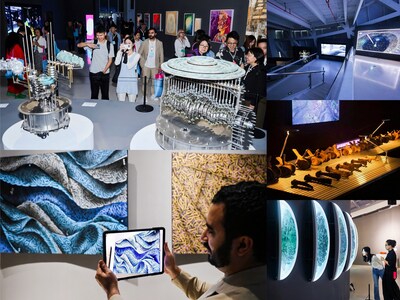Symbiotic Cosmos: A Dialogue on Reconstructing Design Education Ecosystem Amidst Technological Iteration
HANGZHOU, China, Nov. 7, 2025 /PRNewswire/ -- The China (Hangzhou) Art and Technology Biennale opened at Yuhang Art Museum, Hangzhou on October 18. It is initiated by the China Academy of Art (CAA) and curated by the CAA School of Design & Innovation and CAA Art Museum. As a key part of the 3rd Liangzhu Forum, the biennale gathers works by over 160 creators from more than 20 countries and regions, displaying the reconstruction trajectory and future prospects of cultural ecology amid technological iteration.

This biennale is deeply rooted in the disciplinary foundation of the CAA. The Design Studies of CAA adheres to the academic principle of "integrating Eastern and Western cultures" and "innovating from tradition", leading the establishment and development of modern design disciplines in China. Over the years, its achievements have been the forefront and pinnacle of Chinese design education. The CAA has put forward the academic proposition of "Eastern Design Studies", and centered on the development strategy of "Driven by Global and Domestic Vision and Empowered by Culture and Tech Education". Featuring "Design Humanities" and "Art-Technology Integration", it has grown into China's largest, most well-structured design education cluster covering the broadest range of social and industrial needs. With the School of Design & Innovation at the forefront of disciplinary expansion, CAA has been developing cutting-edge, and interdisciplinary innovative design disciplines. It also actively promotes integrated design innovation based on society and industry, and strives to build a "New Bauhaus" and "Vkhutemas" for the era of big data and intelligent media.
This biennale is also inspired by the unique regional culture of Liangzhu in Hangzhou. Liangzhu is the archaeological evidence of China's 5,000-year-old civilization; Hangzhou is not only a famous historical city but also a city of innovation and vitality. Here, ancient civilization and modern technology shine together, serving as a vivid interpretation of the cultural strength of Chinese modernization. This biennale gathers global cutting-edge creations and innovative ideas, continuously influencing industry, education, society, innovation, and other fields. It has become a key hub connecting local wisdom with the global context, making the "Hangzhou Model" a vivid example of the deep integration of culture and technology.
The fundamental mission of art and science is to "discover the world and discover humanity". Through four sections —"Connections: Embodied Interaction", "Symbiosis: Digital Education", "Speculation: Ecological Reconstruction", and "Manifesto: Philosophical Inquiry" — the biennale constructs a narrative framework of "Heaven, Earth, Human, and Machine". The first section allows visitors to experience the connections between humans, machines, and the world through embodied interactions. The second section focuses on promoting the coexistence of humanities and technology through digital education. The third section encourages visitors to speculate on how technology and environment can interact. The final section prompts reflections on the values and ethical boundaries of art-technology integration. These explorations not only continue the century-old academic tradition of CAA, but also demonstrate China's unique approach to engaging in civilizational dialogue amid the wave of globalization.
In the future, CAA will continue to build distinctive, future-oriented and world-class design studies, providing a more comprehensive "CAA solution" for global design education. The China (Hangzhou) Art and Technology Biennale, emerging from this context, will build bridges of dialogue between Liangzhu and the world, between art and technology, allowing ancient wisdom and cutting-edge exploration to resonate in harmony, while enabling artistic intelligence and technological futures to illuminate each other.
The exhibition is curated by Duan Weibin, the dean of the CAA's School of Design&Innovation. The article is also written by Duan Weibin.
Photo - https://mma.prnewswire.com/media/2816789/20251107162936.jpg
![]() View original content:https://www.prnewswire.co.uk/news-releases/symbiotic-cosmos-a-dialogue-on-reconstructing-design-education-ecosystem-amidst-technological-iteration-302608765.html
View original content:https://www.prnewswire.co.uk/news-releases/symbiotic-cosmos-a-dialogue-on-reconstructing-design-education-ecosystem-amidst-technological-iteration-302608765.html

